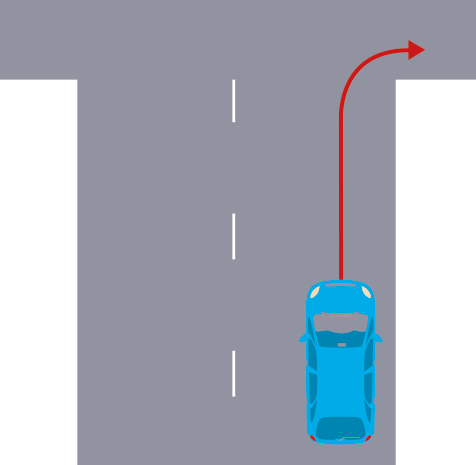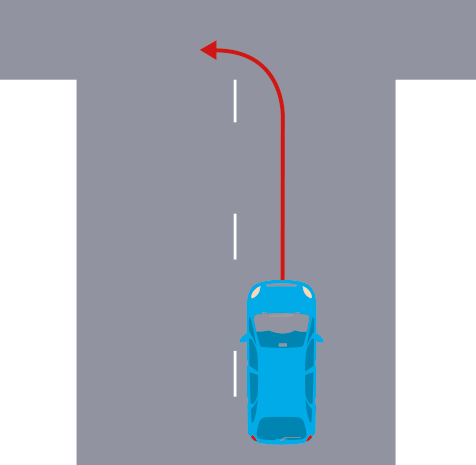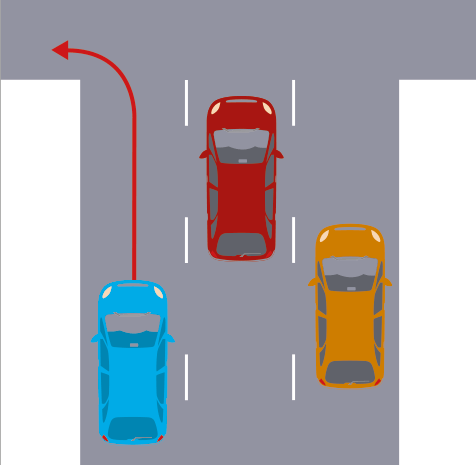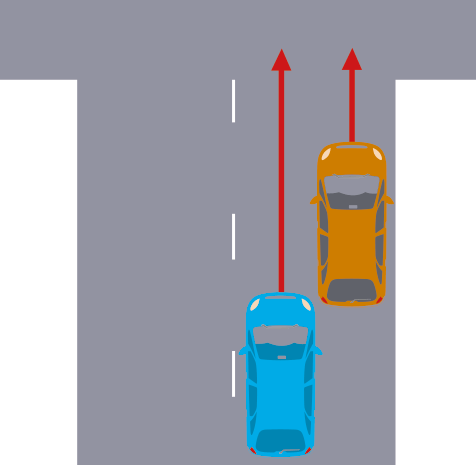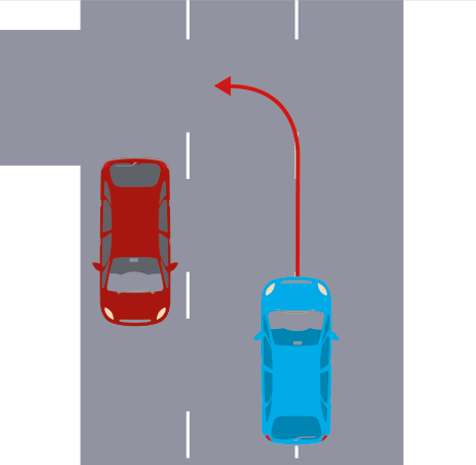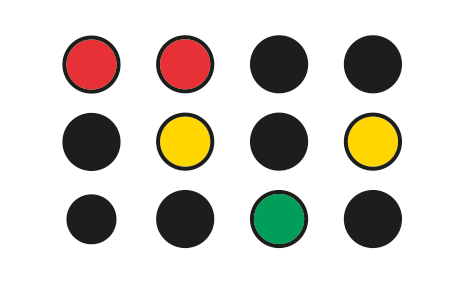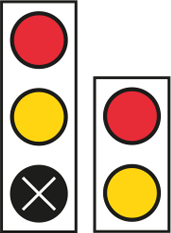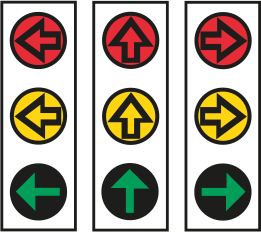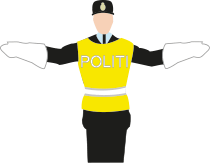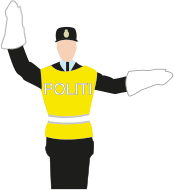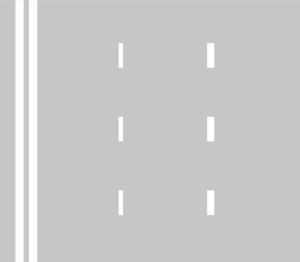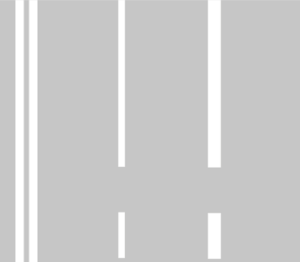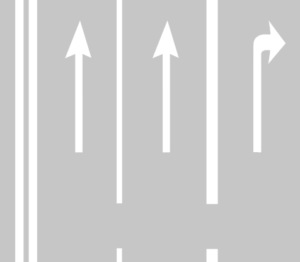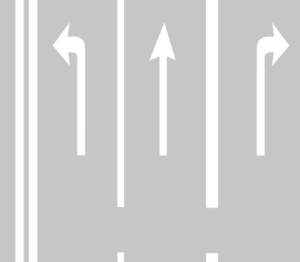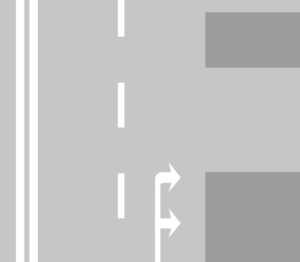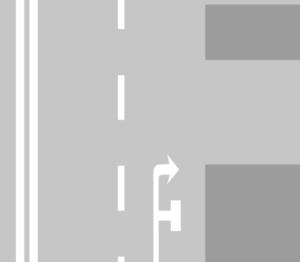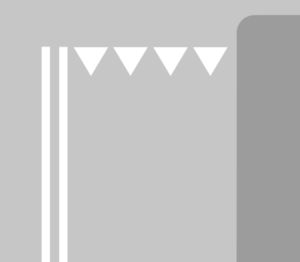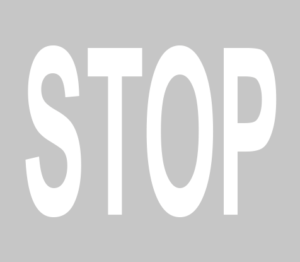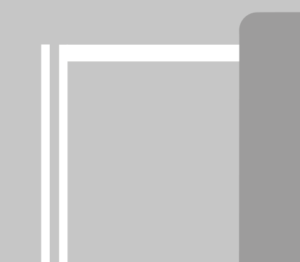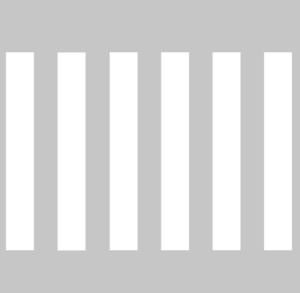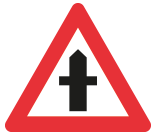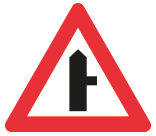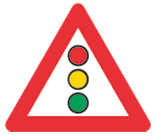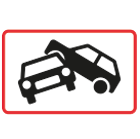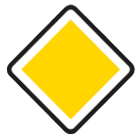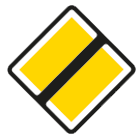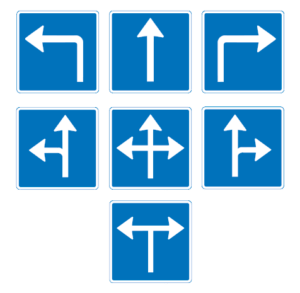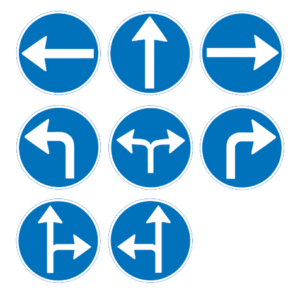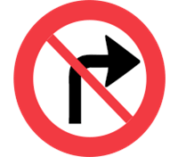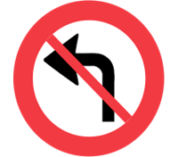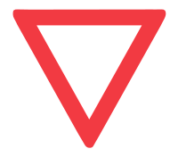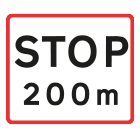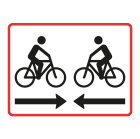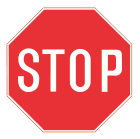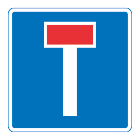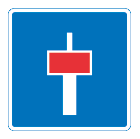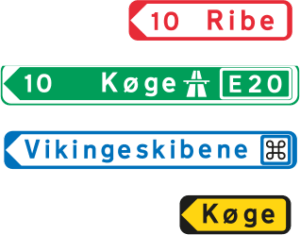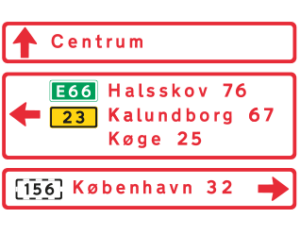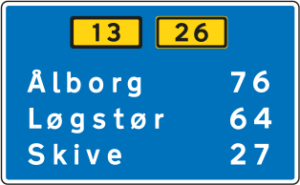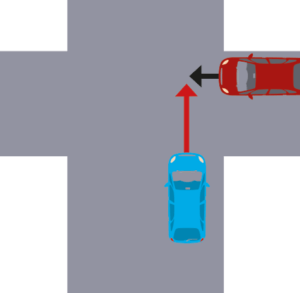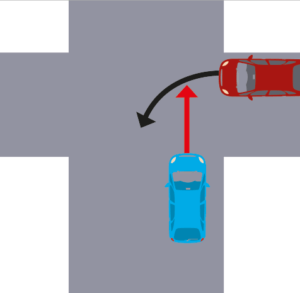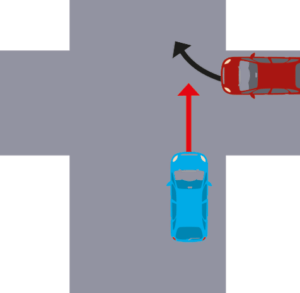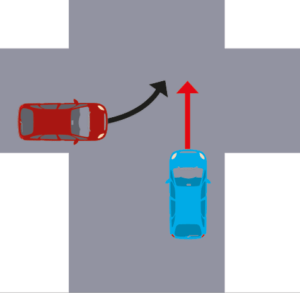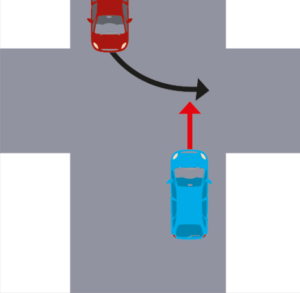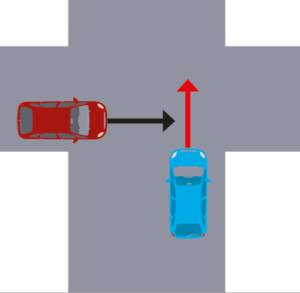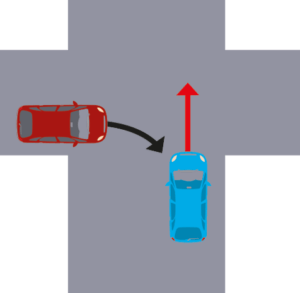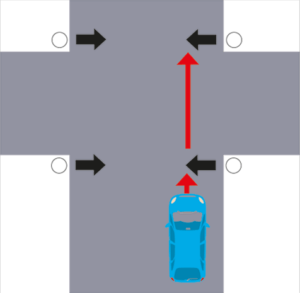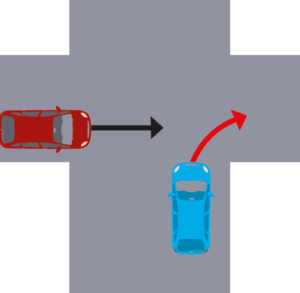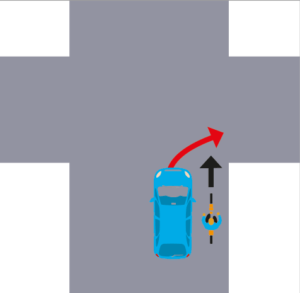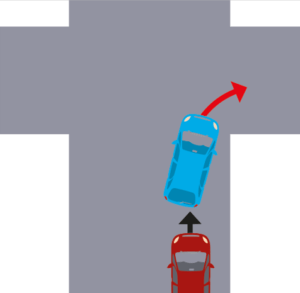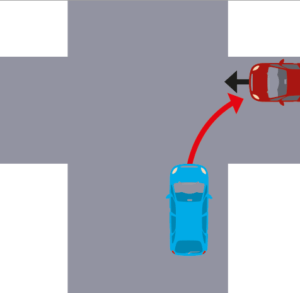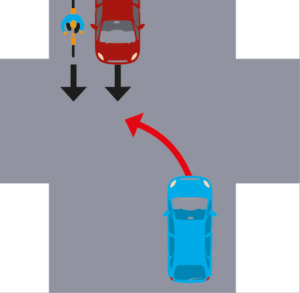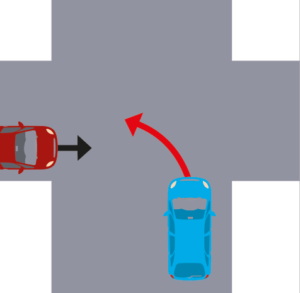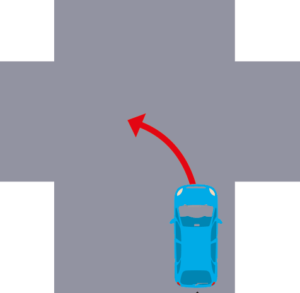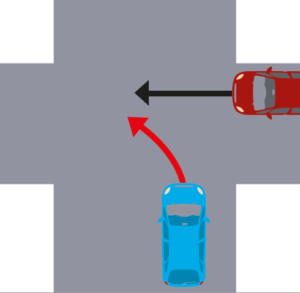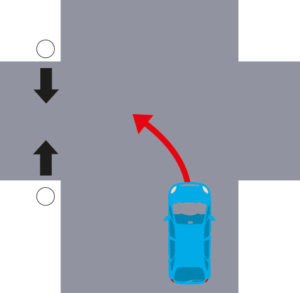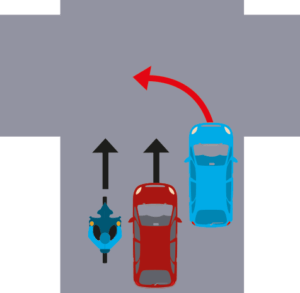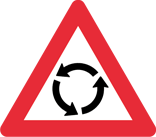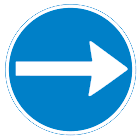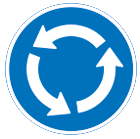Passenger car
Driving school
theory book
to category B
Sections 7.11 - 7.15: Mmanoeuvres at junctions and roundabouts
11. Driving towards an intersection
Remembering about junctions and giving way!
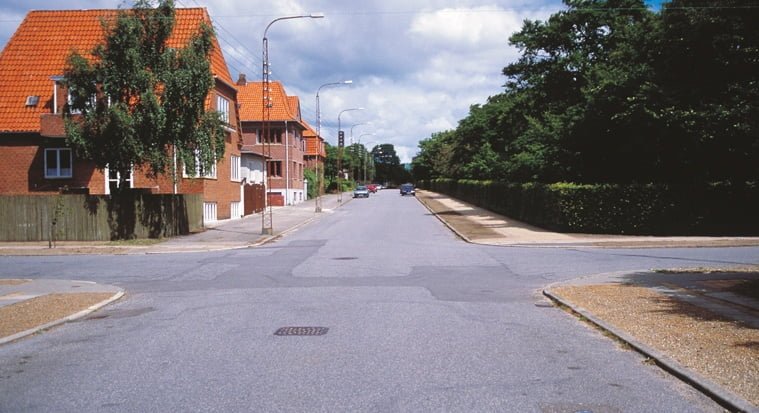
Four-legged crosses.
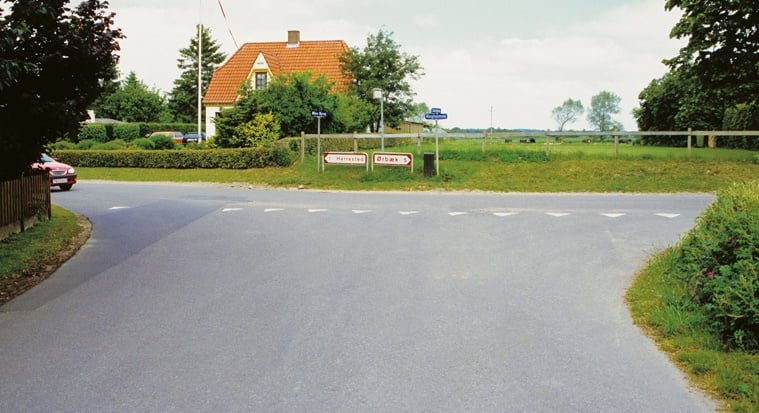
T-junctions.
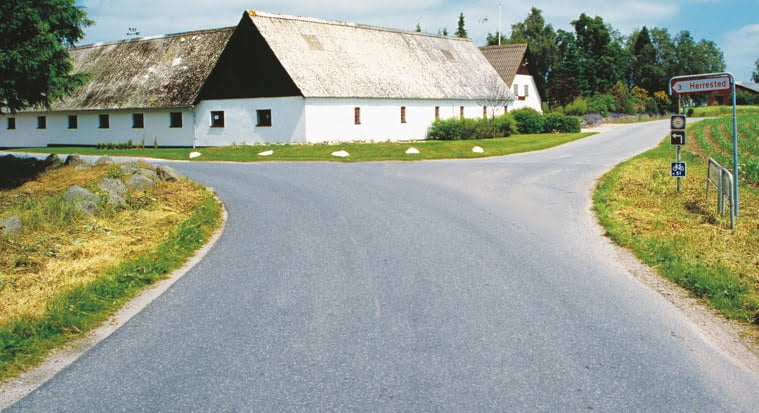
Y-intersection.
There are three types of intersections: the four-legged intersection, the T-intersection and the Y-intersection.
Where roads intersect, there is always a "right of way", which means that there are precise rules about who has to give way to whom.
There are two types of right of way, namely "unconditional right of way" and "right of way". Unconditional right of way means that you must give way to all traffic coming from both the right and the left. Right of way means that you must give way to all traffic coming from the right, but also keep an eye out for any traffic coming from the left.
No matter what type of intersection you're approaching - and no matter what right of way conditions apply - you should always be alert and cautious.
To summarise, at intersections where the unconditional right of way does not apply, the right of way applies.
Some intersections are signalised, but most are not.
Risk conditions
You can avoid creating dangerous situations by keeping your speed low enough. This will allow you to orientate yourself or stop before the intersection. If the intersection is traffic-regulated, there are a number of things you need to pay special attention to - you can read about them on the following pages. Otherwise, the same risks apply at junctions as when changing lanes and driving in front of others.
Orientation and manoeuvring
You need to learn to recognise and manage the following hazardous situations when driving towards an intersection:
- Poor visibility at the intersection.
- Signs that the driver in front of you is slowing down or stopping, for example to enter a driveway just before the intersection.
- Signs that the driver in front of you is slowing down or stopping abruptly for a yellow light or to turn.
- Signs that the driver in the lane to the right or left suddenly changes lanes and pulls in front.
- Signs that pedestrians, especially children and the elderly, will cross the carriageway at the corners of the intersection - even if the light is red.
- Signs that drivers travelling from the left or right are not observing their potential right of way.
Driving towards an intersection - here's how:
- As you approach the intersection, you should familiarise yourself with any signal lights, mandatory lanes, right of way and visibility conditions.
- Show your fellow road users that you intend to obey your right of way.
- Position yourself in the right lane.
- Keep an eye out for pedestrians crossing the carriageway or at any pedestrian crossing.
- If the road has two or more lanes for traffic travelling in the same direction, but no lane arrows, you must move into the rightmost lane when turning right and the leftmost lane when turning left. If you are travelling straight ahead, find the most appropriate lane.
- If the road has no marked lanes, before making a right turn, position yourself as far to the right of the carriageway as possible. For left turns, position yourself at the centre of the carriageway.
- On roads with one-way traffic, position yourself at the left edge of the carriageway when you want to turn left.
And this is also what you do at junctions with poor visibility where you have the right of way:
- Reduce your speed gradually at an appropriate distance from the intersection to show that you will obey your right of way and so that you can stop within the distance to the intersection with the crossing road or to the sharrows, stop line or pedestrian crossing.
- If visibility is poor, it may be necessary to drive a short distance forward across a pedestrian crossing, stop line or shark fence to get a good view.
- Even if you have good visibility, you must stop if a sign, signal or other indication tells you to stop.
- Whether there is a pedestrian crossing or not, if necessary, stop for pedestrians crossing the intersection.
Intersections with poor visibility where traffic from side roads has the right of way:
- Even if you are not the one with the right of way, you must approach the junction at a slow enough speed to stop in case the driver on the side road misses you.
Intersections with poor visibility where the exit is on a pavement, shoulder or cycle path:
- Give way to pedestrians on the pavement and drivers on the cycle path or carriageway.
- Drive slowly. If you need to drive a short distance forward over the pavement, verge or cycle path to get a good view, do it - and stop.
Intersections with good visibility:
- Only stop here if there is a stop sign or if conditions make it necessary.
Intersection with signalling control:
- If the light is red or you can see that it's about to turn red, prepare to stop.
- Stop before a pedestrian crossing or stop line if the signal is red.
- If the signal changes from green to yellow and braking may cause a hazardous situation, continue into the intersection.
- You stop for pedestrians crossing the roadway - even if they have a red light.
- You should not enter the intersection on a green light if the traffic does not allow you to fully cross the intersection. This can cause you to block crossing road users when they get the green light.
Signal lights at intersections
- Main signals. At a red light, stop at the stop line. If there is no stop line, stop a safe distance from the intersection.
- A red and yellow light at the same time also means stop, but indicates that it will soon turn green.
- As you know, a green light means you can drive if the road is clear.
- A yellow light means stop and indicates that it will soon turn red.
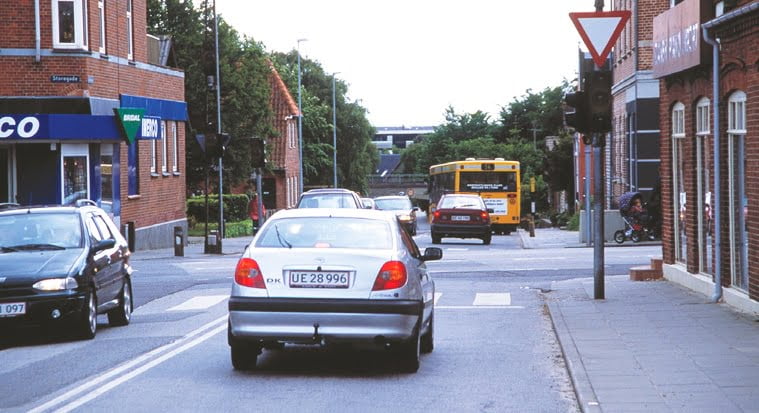
At some junctions, there are both signalling lights and an unconditional right of way sign. The sign only applies if the signal light is not working.
If there is no sign and the light is out of service, the right of way rule applies.
- Signals without green light (repeater signals or minus green). For drivers who are stopped in the centre of the intersection and want to turn left, the signal shows when the light for oncoming traffic changes from extended green to yellow and red. At intersections where the signal light for oncoming traffic does not change at the same time as it does in your direction of travel, the signal may be placed at the corners of the intersection.
Unconditional right of way
The unconditional right of way is sometimes marked with a STOP sign. Other times, it is the Unconditional Right of Way sign or shark teeth, (guard line) that mark the unconditional right of way.
The marking can only be omitted in places where the design of the road clearly indicates that there is an unconditional right of way, such as exiting from a pedestrian zone, recreation and play area, field road, path or similar.
At these locations, you have an unconditional right of way, even if it is not indicated by special road markings:
- exit from a road over a pavement, cycle path or a shoulder that is raised above the level of the carriageway. In addition, the crossing must be made clear by the fact that the pavement of the crossing is different from the pavement of the side road (e.g. cobblestones, concrete paving stones) or that the pavement and/or cycle path is continuous on the more important road, or that it is narrowed in relation to the width of the road.
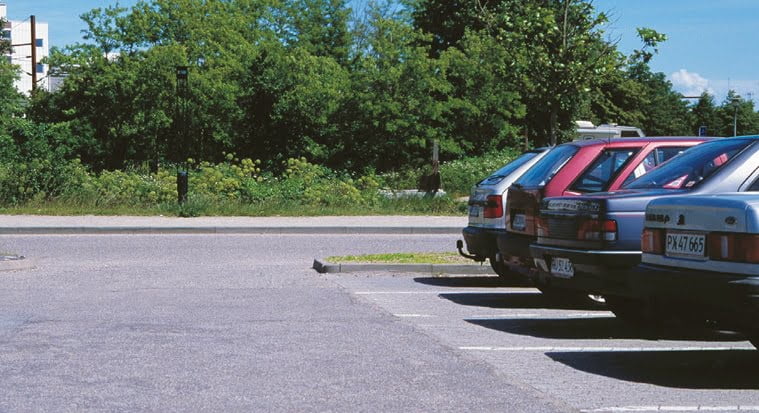
When exiting from an off-road area, for example from a car park, property, plot of land or petrol station, unconditional right of way applies.
Right-hand give way
At intersections where neither road user has an unconditional right of way or in places where road markings are not visible, e.g. after snowfall. after snowfall, the right of way applies. For example, in a car park. This means that you must hold back for all vehicles travelling from the right. But you must also make sure that road users from the left honour their right of way towards you.
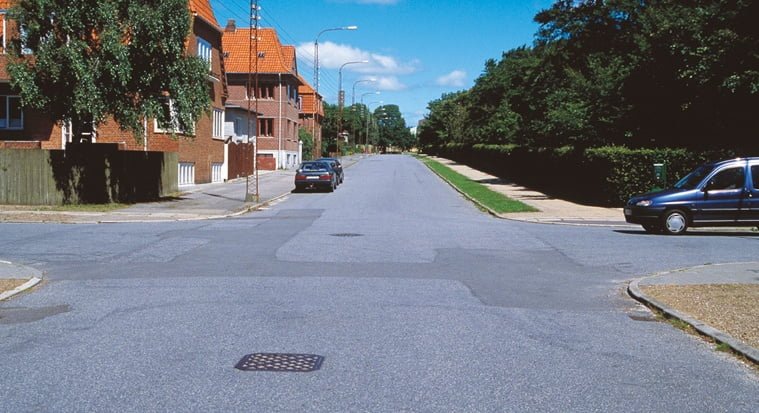
There are no traffic signs or lane stripes for the right of way. This means you need to be extra vigilant at junctions that are not signalised!
12. Straight ahead at intersections
Risks and accidents
When driving straight ahead at intersections, risks often arise because some road users follow the vehicle in front without sufficiently orientating themselves. Other road users expect oncoming drivers who want to turn left - especially at light-controlled intersections - to stop as they should. Unfortunately, this is not always the case, which is why this situation is the cause of many accidents. Dangerous situations can arise if the distance and speed to crossing traffic is misjudged or if crossing pedestrians are overlooked. Young drivers are involved in many accidents on straight-ahead exits, usually because they fail to give way or fail to see oncoming traffic. Straight-ahead driving seems so easy and precise, which is why it can easily go wrong.
Orientation and manoeuvring
You need to learn how to recognise and manage the following hazards when driving straight ahead at intersections:
- Drivers with poor orientation conditions, for example children and elderly people on bicycles, moped riders or motorcyclists in bad weather.
- Vehicles with special speed characteristics that can take a long time to pass the intersection.
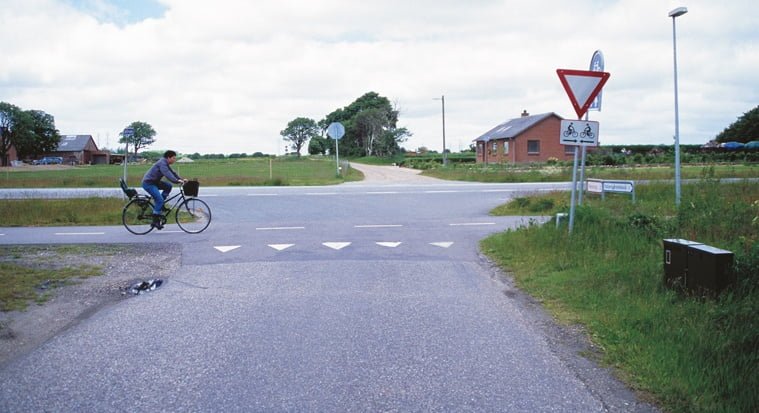
Bi-directional cycle lane on the cross road at the intersection.
- Motorbikes, mopeds and racing bikes, whose speed capabilities can easily be underestimated.
- Vehicles that take up less space in the image and can easily be overlooked when alongside larger vehicles.
- Signs that oncoming drivers are turning left without stopping for you.
- Signs that a cyclist or moped driver in front of you will turn left without looking.
- Drivers slowing down or stopping to turn into a driveway or similar just after the intersection.
- Walking on the far corners of the intersection.
After stopping at an intersection, make sure you have a clear lane to go straight ahead and then start driving as soon as possible.
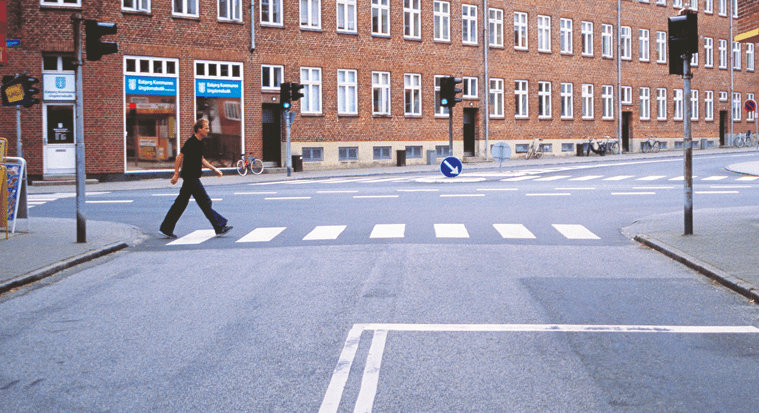
Even if a pedestrian at the intersection jumps a red light when you have the green light, you must stop.
Straight ahead at an intersection - how to do it.
Intersections with poor visibility and at intersections where you have the right of way:
- At the intersection with the crossing road, at sharks' teeth, at the stop line or wherever you have a good view, orientate yourself several times to both sides.
- Is the gap in traffic long enough for you to drive all the way across the intersection without forcing others to slow down or change location?
- At intersections with a right-hand right of way, you judge whether those travelling from the left are observing their right of way. If not, pull back.
- Look for pedestrians stepping out onto the road at the opposite corners of the junction.
- Also orientate yourself to the clear lane ahead before entering the intersection.
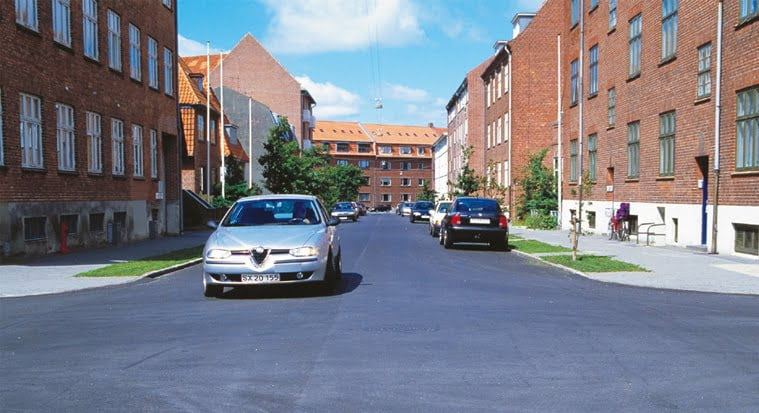
Judge whether oncoming traffic or cyclists and moped riders in front who want to turn left are holding back.
Intersections with poor visibility where traffic from the side road has the right of way:
- Do drivers on the left and right respect their right of way?
- By the way, judge the traffic as described in the last three points above.
Intersection with signalling control:
- After stopping at a red light, keep an eye on the signal light and any arrow signals.
- Avoid focusing all your attention on the traffic lights, also keep an eye on the traffic in the intersection, especially pedestrians crossing the carriageway. Even if they have a red light.
- Look for oncoming traffic. Is there any sign that they're about to turn left without stopping?
13. Right turn at intersections
Risks and accidents
When turning right at an intersection, there is a risk that some road users will follow the vehicle in front without sufficiently orientating themselves. In addition, many people drive too fast through the bend and lose control of the car. Some expect other drivers on the left side of the junction to always obey their right of way or respect the traffic lights. Dangerous situations can also arise if the distance and speed of crossing traffic is misjudged or if crossing pedestrians are overlooked.
Finally, hazardous situations can arise if road users do not orientate themselves sufficiently behind cyclists and moped riders or simply misjudge their speed.
During right turns, accidents are mainly caused by drivers approaching from behind and from the sides. Often cyclists and moped riders are hit as they are travelling on the right side of the car and are overlooked. Other accidents are caused by drivers rear-ending a road user who is about to turn right.
Pedestrians on the road the driver is turning onto are often involved in right-turn accidents.
Orientation and manoeuvring
You need to learn to recognise and manage the following right turn hazards:
- Bi-directional cycle lane on the cross road.
- Reduced traction due to road surface or road surface conditions.
- Travelling from the left side with special orientation difficulties.
- Vehicles whose speed capabilities can easily be underestimated.
- Cyclists and moped riders who can easily be hidden in the blind spot to the rear right.
- Oncoming cyclists and moped riders on a two-way cycle path.
- Signs that oncoming traffic is turning left without stopping.
- Pedestrians entering the crosswalk or children on corners.
- Blocked lane, for example a vehicle stopping just after the intersection.
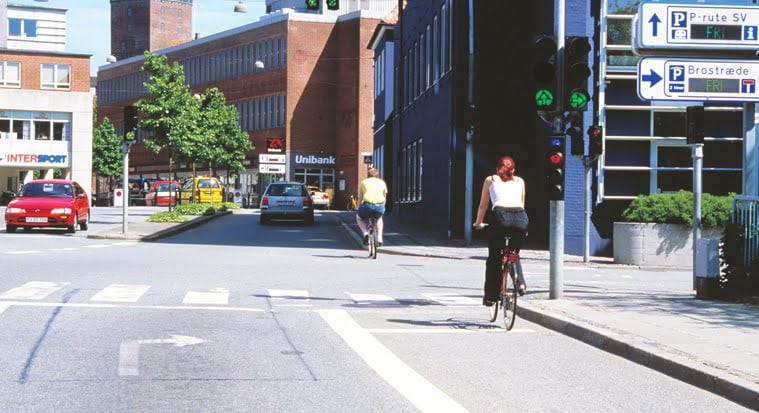
Look for signs ofthat cyclists and moped riders who want to go straight ahead continue to drive despite a stop signal.
How to make a right turn at an intersection:
- Signal well in advance to show that you want to turn right.
- Keep your speed low enough so that you can familiarise yourself with the conditions at the intersection well in advance. Are there cycle lanes and how are cyclists and moped riders positioned?
- Position yourself in the right lane. Drive right up to the edge of the carriageway or kerb to prevent cyclists and moped riders from coming up on the right side of the car. Then you know they're not on the side of the car when you turn.
- Is there an opportunity to overtake any cyclists and moped riders before pulling out into the right-turn lane? If not, pull in behind them - and not too close.
- After stopping, orientate yourself carefully to both sides and especially in the blind spot behind you to the right, where cyclists and moped riders can easily be hidden.
- If you have the right of way, you need to assess whether the gap in traffic from the left is large enough to allow you to turn right without forcing others to slow down or change position.
- Do drivers coming from the left respect their right of way?
- Do oncoming drivers who want to turn left hold back?
- Look for pedestrians exiting the intersection.
- Turn as quickly as possible when the road is clear. Remember to take into account the sharpness of the corner and grip.
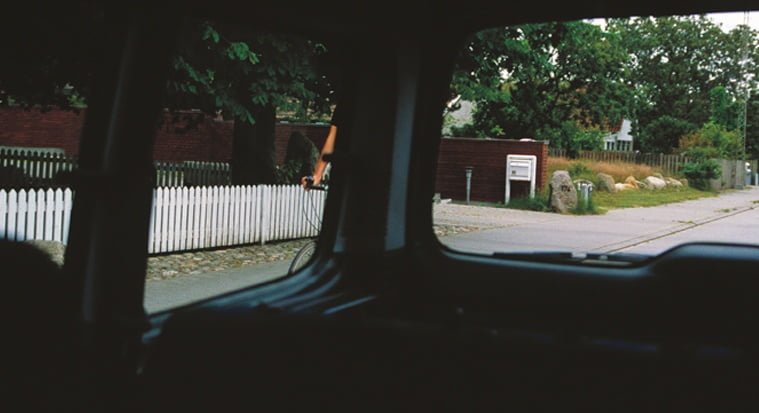
Keep back for cyclists and moped riders who want to go straight on the cycle path.
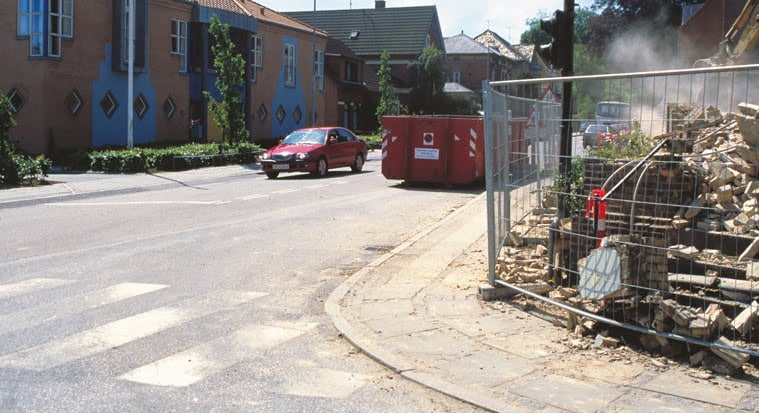
Look to the right at the junction. If the carriageway is not completely clear after the bend, take this into account when turning.
Right turns at junctions - how to turn right at junctions with a cycle lane with and without a cycle lane:
Look out for cyclists and moped riders, both those approaching from the front (on a dual carriageway) and those approaching from behind, as well as cyclists in bike lanes. Can you turn right without forcing them to slow down or stop?
Intersection with signalling control:
- After stopping at a red light, keep an eye on the signal light and any arrow signals.
- Avoid focusing all your attention on the traffic lights, also keep an eye on the traffic in the intersection, especially pedestrians crossing the carriageway. Even if they have a red light.
- Look for oncoming drivers who want to turn left. Are there any signs that they're about to turn without stopping?
- Judge whether cyclists and moped riders stop for a red cycle signal before turning.
T-junction with turning from side road:
Stop if necessary to find a gap in traffic from the left that is large enough for you to turn right. Also pay attention at T-junctions with a right-hand give-way, because road users on the crossing road often drive as if traffic from the side road has an unconditional right of way.
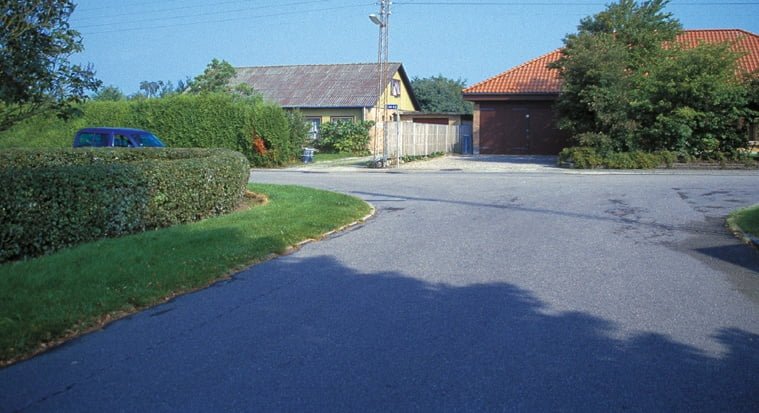
At this T-junction with right-hand give way, you will turn right. Even though it's the road users from the left who should be holding back for you, make sure they have actually seen you and are holding back for you.
14. Left turn at an intersection
Risks and accidents
Left turns at intersections are one of the most dangerous manoeuvres in traffic. Some road users tend to follow the car in front of them without sufficiently orientating themselves. In addition, many drive too fast through the bend and lose control of the car.
Some people expect drivers on the sides of the road to always obey their right of way or respect the traffic lights. But that's not always the case.
Dangerous situations can also arise if you misjudge the distance and speed of cross traffic or oncoming traffic. It can also be dangerous to concentrate too much on oncoming traffic, as this can cause you to overlook other hazards. Dangers can also arise if you pay too much attention to the signal light.
Many people drive through a green light without noticing oncoming traffic that has not yet fully exited the intersection. Some people feel annoyed or uncomfortable waiting for a long time in an exposed position in the middle of the intersection. Others get impatient because there are always oncoming vehicles to hold back from. Others get nervous about getting in the way when crossing traffic gets the green light. Finally, dangerous situations can arise if the road user does not orientate themselves properly forwards to crossing pedestrians and backwards to cyclists and moped riders, for example on a two-way cycle path.
Many accidents involving young drivers occur when turning left at intersections. These accidents are mainly caused by the left-turning driver failing to stop for oncoming traffic. These accidents happen with cars, bicycles and motorcycles.
Often accidents occur with drivers approaching from the sides or rear-end drivers driving in the blind spot on the left side of the car.
Finally, pedestrians are at risk when crossing the lane that the left-turning driver is entering.
Orientation and manoeuvring
You need to learn how to recognise and manage the following hazardous situations when turning left at intersections:
- Road users coming from behind on the left side of the car.
- Bi-directional cycle path on the cross road.
- Reduced traction due to road surface or road surface conditions.
- Travelling from the left side with special orientation difficulties.
- Vehicles whose speed capabilities can easily be underestimated.
- Vehicles that take up less space in the image and can easily be overlooked when alongside larger vehicles.
- Cyclists and moped riders coming from the left on a two-way cycle path.
- Oncoming drivers going straight ahead at an intersection that is completely or partially obscured by vehicles waiting to make a left turn.
- Pedestrians crossing the carriageway or entering the pedestrian crossing at the exit of the intersection.
- Children on the corners at the exit of the intersection.
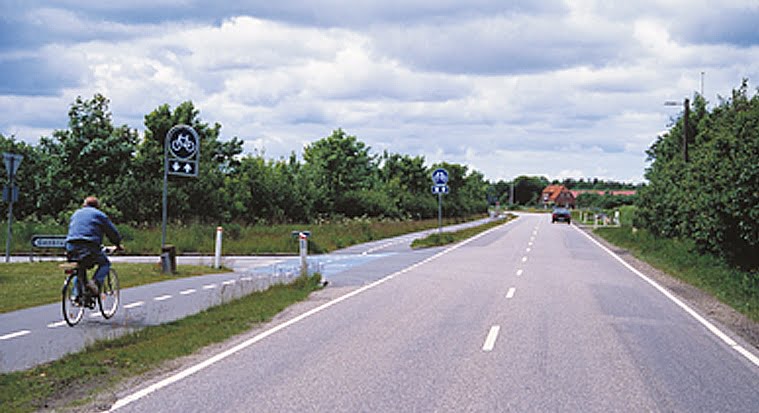
Bi-directional cycle paths require extra attention because you need to watch out for cyclists and moped riders from both left and right, or from the front and back.
How to make a left turn at an intersection:
- Is there a tailgater on the left side of the car?
- Signal well in advance that you want to turn left.
- Position yourself in the leftmost lane or in the mandatory lane.
- Keep your speed low enough to allow you to adapt to visibility and right of way conditions.
- Keep back for oncoming traffic.
- Orient yourself several times to both sides.
- Is the gap in oncoming traffic or traffic from the left or right large enough to allow you to turn left or proceed to the turning lane in the middle of the intersection without forcing others to slow down or change position?
- Do drivers from both sides of the intersection respect their right of way?
- If there is a two-way cycle lane on the left side of the junction, keep an eye out for cyclists and moped riders coming from behind.
- Look for pedestrians exiting the intersection.
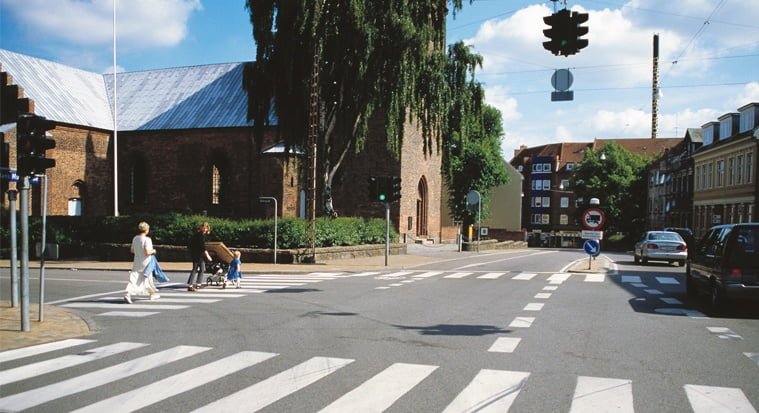
Look left at the junction. If the carriageway is not completely clear after the bend, take this into account before you turn.
And that's how you do it at every intersection:
- When positioning or driving towards the centre of the intersection, you must show oncoming drivers who will also be turning left how you will pass them.
- If necessary, yield to pedestrians who are crossing the carriageway you are turning into or who are entering a pedestrian crossing.
- Keep clear of cyclists and moped riders entering the intersection from a cycle lane.
- Position yourself on the right side of the lane you are turning into. If there are multiple lanes in the same direction, before turning, choose the lane that is most appropriate for your target and other traffic.
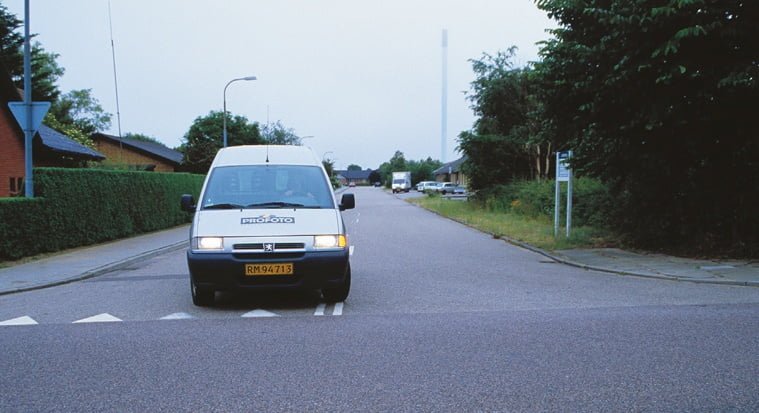
Wait to turn left if your view is blocked by oncoming drivers who are also waiting to turn left.
Intersection with signalling control:
- After stopping at a red light, keep an eye on the signal light and any arrow signals.
- Avoid focusing all your attention on the traffic lights, but also keep an eye on the traffic in the intersection, especially pedestrians crossing the carriageway. Even if they have a red light.
- Pull in behind any vehicles in front of you that are also turning left, but only if you estimate that you can complete the left turn before the light turns green for cross traffic.
- Judge if oncoming traffic is holding back. Make sure the intersection is clear when it turns yellow or shows a green left arrow and be ready to brake.
- Turn as quickly as possible when the lane is clear and when the signal light shows green light, green left arrow or the repeater signal shows yellow/red light.
Intersections where you have unconditional right of way:
- Stop if necessary to wait for a sufficient gap in oncoming traffic and traffic from the left and right to complete the left turn.
- If the junction has a turning lane at the junction or a waiting area in the middle of the road, wait there until there is enough space for a left turn.
Intersection with right of way:
- Stay at the beginning of the junction until you can proceed without risk of blocking traffic.
- Allow sufficient space for oncoming traffic and traffic from the right before completing the left turn.
Intersections where cross traffic has unconditional right of way and T-junctions when turning onto a side road:
- Drive slowly towards the centre of the intersection and wait until there is enough space to turn left.
If you need to turn left from the centre of a road with no turning lane and no central reservation, do not turn the front wheels to the left before you start turning.
T-junction with turning from side road:
- Here, you stop at the intersection with the crossing road (possibly at a shark fence or stop line) to wait for room to turn. This also applies to T-junctions with right-hand priority, as road users on the crossing road often drive as if traffic from the side road has unrestricted right of way.
- Pull in behind any vehicles in front of you that also need to turn left, but only if you estimate that the left turn can be completed before the traffic light changes to green for cross traffic.
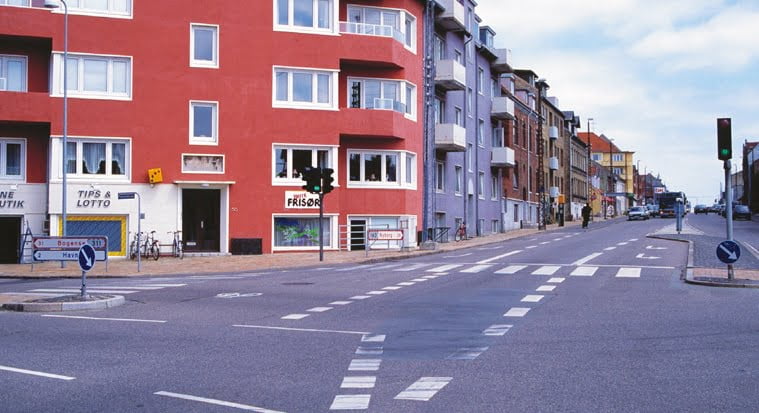
Turn as soon as possible when the lane is clear and when the signal light shows green light, green left arrow or the repeater signal shows yellow/red light.
15. Driving in a roundabout
Risks and accidents
If you drive too fast towards a roundabout, orientation becomes poor and it's difficult to keep to the right of way. If the speed is too high in the roundabout itself, it is difficult to keep the correct position.
Misjudging the grip or speed of other drivers on the roundabout can also lead to dangerous situations.
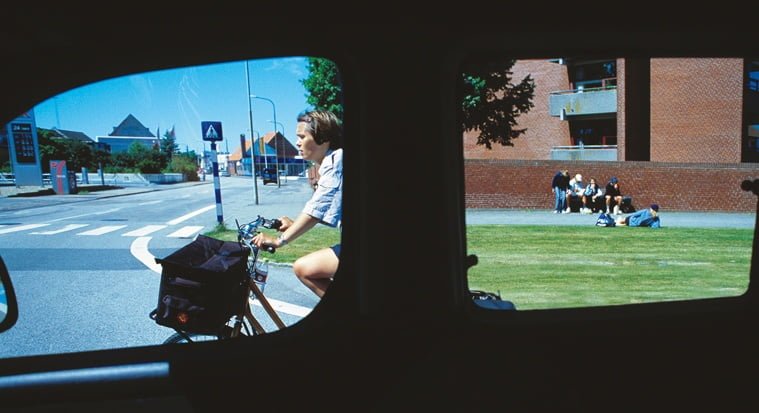
The most common type of accident involving drivers on roundabouts is when drivers on the roundabout and road users entering the roundabout collide. It can be dangerous if, on your way out of the roundabout, you don't properly orientate yourself to cyclists and moped riders coming from behind and entering the roundabout, or pedestrians crossing the carriageway. These situations are the cause of many accidents.
Orientation and manoeuvring
Learn to recognise and manage the following hazardous situations when driving in a roundabout:
- Reduced traction due to the road surface.
- Vehicles from the left side inside the roundabout with speed characteristics that can easily be underestimated.
- Rear-entering cyclists and moped riders who may be hidden in the blind spot to the rear right.
- Signs that as you exit the roundabout, there are cyclists and moped riders who continue even if there is a red cycle signal, green right arrow or green light for cars.
- Pedestrians who are about to cross the carriageway as you exit the roundabout.
Approaching a roundabout - here's how
- Drive at a low enough speed that you can orientate yourself to any designated lanes, traffic signals and give way when approaching a roundabout.
- Are there cyclists and mopeds on your right?
- Select the designated lane or the one that is most appropriate.
- Before moving into the right lane, orientate yourself as you would for a right turn, and before moving into the left lane, as you would for a left turn.
- Are there crossing pedestrians and drivers coming from the left?
- Hold back pedestrians if necessary.
- If you need to exit the first side road, select the right lane and turn right.
- If you are exiting the last side road, you can signal with your left indicator to show other road users your intention.
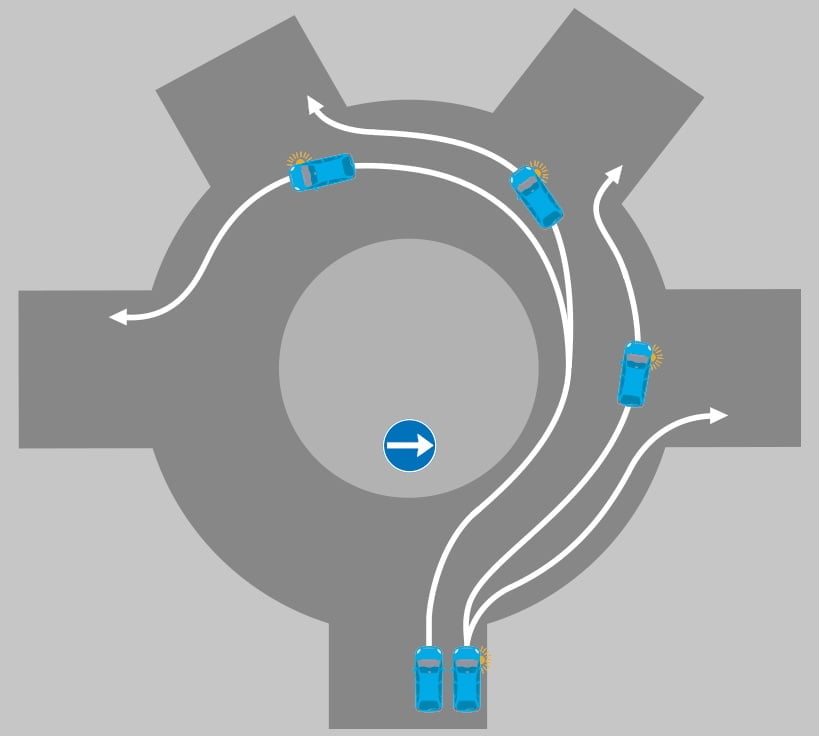
How to exit from a roundabout
Orient yourself as if you were driving in front of, behind or beside others and do the same.
When exiting the first side road:
- Stay in the right lane and drive as close to the edge of the carriageway as possible or choose any designated lane while continuing to flash right.
- Pull back before the exit for cyclists and moped riders, as with right turns at junctions.
- Position yourself in relation to and keep back from cyclists and moped riders as you would when turning right at an intersection.
- If necessary, give way to pedestrians who are crossing the carriageway on the exit or who are entering a pedestrian crossing.
When exiting between the first and last side road:
- Choose the lane that is most appropriate for the road conditions and the purpose of your journey. In other words, where you are going.
- Change to the right lane and signal as if exiting on the last side road.
- Position yourself in relation to cyclists and moped riders as you would when turning right at an intersection.
- If necessary, give way to pedestrians who are crossing the carriageway on the exit or who are entering a pedestrian crossing.
At the exit of the last side road:
- Move into the left lane or any designated lane and signal with the left turn signal to guide others.
- Change to the right lane or to any designated lane (following the lane change rule). Signal with your turn signal for a right turn on the side road before the one you want to exit.
- Position yourself in relation to cyclists and moped riders as you would when turning right at an intersection.
- If necessary, give way to pedestrians who are crossing the carriageway on the exit or who are entering a pedestrian crossing.
Test your knowledge
Cat. B - Sections 7.11 - 7.15
Select the questions you think are the right ones.
